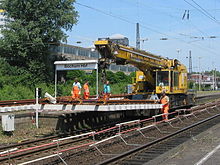Slewing rail crane


A slewing rail crane is a crane that is rotatably mounted on a rail vehicle. In the area of the Deutsche Reichsbahn (DR) in the GDR it was also called the railway slewing crane (EDK).
These are mainly used to salvage derailed rail vehicles or during construction work on railway lines, for example to assemble tracks , switches and bridges. The construction train is often used on a track parallel to the construction site .
history
The first rail cranes were built on flat wagons with hand-operated winches. From 1860 there were also steam-powered cranes, developed by the British company Appleby Brothers. The first rail steam cranes were not manufactured in Germany until thirty years later. After 1900, cranes were also built so that they could be placed on normal trains, which made transportation easier. Alternatively, crane locomotives were used. The diesel drive was tried out from 1930, but powerful diesel engines were still missing. It was not until 1960 that diesel-hydraulic cranes became standard in Germany . The Deutsche Reichsbahn in the GDR also had diesel-electric cranes. From 1960 onwards, hydraulic telescopic booms were used instead of conventional booms moved with ropes. Today only such booms are built.
Well-known manufacturers of railway cranes were Kirow Leipzig , Krupp-Ardelt , SMS Demag and Leo Gottwald KG .
present
DB emergency cranes
Today only world market leader Kirow Ardelt is active in this area. The German train uses modern rail cranes of series 732 and 733 as an emergency cranes one, they can lift loads up to 160 tons.
Railway construction cranes
The Kirow Rail Cranes (KRC) from Kirow Ardelt are also known as heavy-duty hoists.
- KRC 1200 T Multi Tasker
The KRC 1200 T Multi Tasker from Kirow Ardelt , presented in 2016, travels in a train at speeds of up to 100 km / h. The counterweights are slidable on a flat car and can be picked up automatically. Thanks to the double slewing ring , the counterweight including the superstructure can remain in the direction of the track axis, while only the boom swings out by up to 30 °. The telescopic arm can be extended and retracted under load and can also be used horizontally, for example in confined spaces. The load capacity is 250 t, the load moment can reach up to 2800 ton meters. Four supports can also be used individually as required. While the slewing ring can be leveled up against a track elevation of up to 180 mm, the eight axes of the crane carriage remain on the track and can move the crane.
Crane beams are used to lift longer loads in several places at the same time. Such beams can be equipped with a slewing ring which makes the beam with its load rotatable about the vertical axis with respect to the crane hook. Sometimes it is possible to shift the load to a certain extent by telescoping the legs of the crane beam in opposite directions.
- KRC 810 T
A slightly smaller type is the KRC 810 T (Multi Tasker) track construction crane . There are also a number of other slewing rail cranes from the manufacturer.
literature
Web links
- More information about cranes and other railway service vehicles (navigation on the right, please scroll to crane vehicles)
Individual evidence
- ↑ Kirov. Multi tasker. Accident service. youtube.com, Kranunion, published August 11, 2016, accessed May 31, 2018.
- ↑ Kirov. Multi tasker. Accident service. youtube.com, Kranunion, published August 11, 2016, accessed May 31, 2018.
- ↑ jib cranes for Kirov Sersa Group youtube.com, DLProduktionc, published December 16th 2011, accessed 31 May 2018.

